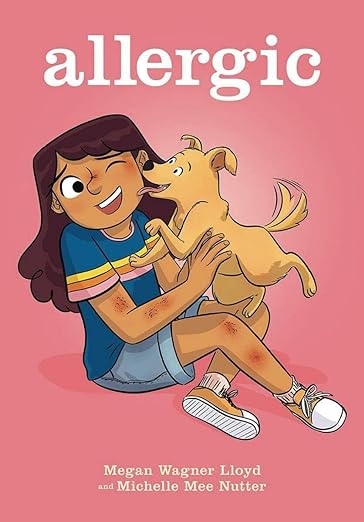WRAP-UP
Allergic Conditions Unit
Now that you’ve had the Allergic Conditions unit, here are a few follow up activities so you can learn more and have fun. Choose one, two or all three!
Read the book
Allergic: A Graphic Novel, by Megan Wagner Lloyd (author) and Michelle Mee Nutter (illustrator)
And, as a free e-book through the Minuteman Library Network: https://find.minlib.net/iii/encore/record/C__Rb3994804
Need more help? Check with your school librarian or your local library. For more ways to find books, you can click this link: Find Books!
If you have any trouble getting the book from a library, here is a link to a read-aloud of the book on YouTube:
Allergic Conditions Activity
Try This!
Offline activity: Be an Allergen Detective! Help find the foods that trigger an allergic reaction.
- Collect food wrappers that list ingredients. This can usually be found somewhere on the package.
- Check to see if you find any of the top allergens (these must be labeled):
- eggs
- milk
- peanuts
- soy
- wheat
- tree nuts (such as almonds, walnuts, pecans, cashews, pistachios)
- sesame
- fish
- crustacean shellfish (such as lobster, shrimp and crab)
- Circle the items on the label or write down on paper the allergens you find.
Did you find any labels that didn’t have allergens? What are some foods you can think of that could be safe for someone with food allergies?
Remember!
- Never share food.
- Keep your hands and surfaces clean after eating
- Find ways to include friends with allergies and celebrate special occasions with more than just food.



Interview an Expert!
Ask a parent if you have a relative or family friend with an allergic condition. Contact that person and interview them using this conversation starter and questions (but feel free to ask some of your own, too!).
Try This!
Interview an Expert with an Allergic Condition
Conversation Starter – Use this screen or download the pdf and print:
Interview an Expert with Allergic Conditions PDF
Thank you for talking to me. I am learning about allergic conditions through the Understanding Our Differences program at school. I’d like to ask you a few questions so I can understand your experiences.
- How and when did you find out you had allergies? Was it something you had from when you were little or were you older when you found out?
- Do you use any special techniques, strategies or technology to help you manage your allergies?
- Have you ever had someone treat you differently because you have allergies? How do you want people to treat you? What is your favorite way for people to offer help? What kinds of hobbies or activities do you enjoy? Is there anything special you have to do to enjoy them?
I’ve learned that it’s important to understand people’s experiences with disabilities, and also to understand what people have in common. (Tell the person if you too like one of their hobbies or interests.)

The Understanding Our Differences curriculum is protected by copyright, © 2010-2023. Understanding Our Differences, Inc. All rights reserved. The Understanding Our Differences curriculum is not to be altered, photocopied, shared with other entities, or reproduced in any way, and is not to be resold.

